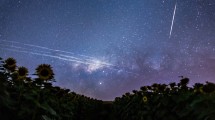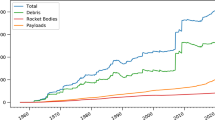Abstract
The shell bound by the Karman line at a height of ~80–100 km above the Earth’s surface and geosynchronous orbit at ~36,000 km is defined as the orbital space surrounding the Earth. It is within this region, and especially in low Earth orbit, where environmental issues are becoming urgent because of the rapid growth of the anthropogenic space object population, including satellite ‘mega-constellations’. In this Perspective, we summarize the case for considering the orbital space around the Earth as an additional ecosystem, subject to the same care and concerns, and the same broad regulations as the oceans and the atmosphere, for example. We rely on the orbital space environment by looking through it, as well as by working within it. Hence, we should consider damage to professional astronomy, public stargazing, and the cultural importance of the sky, as well as the sustainability of commercial, civic, and military activity in space. Damage to the orbital space environment has problematic features in common with other types of environmental issue. First, the observed and predicted damage is incremental and complex, with many contributors. Second, whether or not space is formally and legally seen as a global commons, the growing commercial exploitation of what may seem to be a ‘free’ resource is in fact externalizing the true costs.
This is a preview of subscription content, access via your institution
Access options
Access Nature and 54 other Nature Portfolio journals
Get Nature+, our best-value online-access subscription
$29.99 / 30 days
cancel any time
Subscribe to this journal
Receive 12 digital issues and online access to articles
$119.00 per year
only $9.92 per issue
Buy this article
- Purchase on SpringerLink
- Instant access to full article PDF
Prices may be subject to local taxes which are calculated during checkout






Similar content being viewed by others
Data availability
The datasets and Jupyter notebooks used in the construction of Figs. 1, 2 and 6 are available via GitHub at https://github.com/andyxerxes/Space-environment-paper. The datasets used for Fig. 3 are available at https://doi.org/10.18738/T8/LHX5KM.
References
Lawrence, A. Brief of Professor A. Lawrence as Amicus Curiae, USCA Case #21-1123 Document No. 1910216 (US Court of Appeal, 2021); https://andyxlastro.me/losing-the-sky-resources/
Miraux, L. Environmental limits to the space sector’s growth. Sci. Total Environ. 806, 150862 (2021).
Lawrence, A. Losing The Sky (Photon Productions, 2020).
Long, G. The Impact of Large Constellations of Satellites Document No. JSR-20-2H (JASON Programme Office, Mitre Corporation, 2021); https://www.nsf.gov/news/special_reports/jasonreportconstellations/
Rwanda files at ITU for nearly 330,000 satellites. SpaceWatch Africa (22 October 2021); https://spacewatch.global/2021/10/rwanda-files-at-itu-for-nearly-330000-satellites
Walker, C. et al. Impact of satellite constellations on optical astronomy and recommendations towards mitigations. Bull. Am. Astron. Soc. 52, 0206 (2020).
Hall, J. et al. Executive Summary. In Report of the SATCON2 Workshop, 12–16 July 2021 (AAS, 2021); https://doi.org/10.3847/25c2cfeb.4554c01f
Rawls, M. L. et al. Observations Working Group Report. In Report of the SATCON2 Workshop, 12–16 July 2021 (AAS, 2021); https://baas.aas.org/pub/004iuwwu
Venkatesan, A. Community Engagement Working Group Report. In Report of the SATCON2 Workshop, 12–16 July 2021 (AAS, 2021); https://baas.aas.org/pub/enwrps6k
Walker, C. et al. Dark and Quiet Skies for Science and Society: Report and Recommendations (UN Office for Outer Space Affairs, 2021); https://noirlab.edu/public/products/techdocs/techdoc021/
Walker, C. & Benvenuti, P. (eds) Dark and Quiet Skies II for Science and Society (UN Office for Outer Space Affairs, 2022); https://noirlab.edu/public/products/techdocs/techdoc051
McDowell, J. General Catalog of Artificial Space Objects Release 1.2.3. (2020); https://planet4589.org/space/gcat
Space Debris by the Numbers (ESA, 2022); https://www.esa.int/Safety_Security/Space_Debris/Space_debris_by_the_numbers
Orbital Debris Mitigation Standard Practices (NASA Orbital Debris Program Office, 2019); https://orbitaldebris.jsc.nasa.gov/library/usg_orbital_debris_mitigation_standard_practices_november_2019.pdf
Treaty on Principles Governing the Activities of States in the Exploration and Use of Outer Space, Including the Moon and Other Celestial Bodies (UN Office for Outer Space Afffairs, 1967); https://www.unoosa.org/oosa/en/ourwork/spacelaw/treaties/outerspacetreaty.html
Convention on International Liability for Damage Caused by Space Objects (UN Office for Outer Space Affairs, 1972); https://www.unoosa.org/oosa/en/ourwork/spacelaw/treaties/liability-convention.html
Jah, M. Discovering the interconnection between Heaven and Earth. Aerospace America (May 2021); https://aerospaceamerica.aiaa.org/departments/discovering-the-interconnection-between-heaven-and-earth/
Jah, M. Where to find fresh talent for the space tracking field. Aerospace America (July/August 2021); https://aerospaceamerica.aiaa.org/departments/where-to-find-fresh-talent-for-the-space-tracking-field/
G7 Nations Commit to the Safe and Sustainable Use of Space (UK Space Agency, 2021); https://www.gov.uk/government/news/g7-nations-commit-to-the-safe-and-sustainable-use-of-space
Space Sustainability Rating (World Economic Forum, 2021); https://espace.epfl.ch/research/space-sustainability-rating
Mroz, P. et al. Impact of the Starlink satellites on the Zwicky Transient Facility Survey observations. Astrophys. J. Lett. 924, L30 (2022).
Bassa, C. G., Hainaut, O. R. & Galadi-Enriquez, D. Analytical simulations of the effect of satellite constellations on optical and near-infrared observations. Astron. Astrophys. 657, A75 (2021).
Tyson, J. A. et al. Mitigation of LEO satellite brightness and trail effects on the Rubin Observatory LSST. Astron. J. 160, 226 (2020).
Feuge-Miller, B. et al. ASTRIANet Data for: Python Computational Inference from Structure (PyCIS). Texas Data Repository https://doi.org/10.18738/T8/GV0ASD (2021).
Kucharski, D. et al. Full attitude state reconstruction of tumbling space debris TOPEX/Poseidon via light-curve inversion with Quanta photogrammetry. Acta Astronaut. 187, 115–122 (2021).
Mallama, A. The brightness of VisorSat design Starlink satellites. Preprint at https://arxiv.org/abs/2101.00374 (2021).
Michalowoski, M. J. et al. GN-z11 flash was a signal from a man-made satellite not a gamma-ray burst at redshift 11. Nat. Astron. 5, 995–997 (2021).
Lawler, S. M., Boley, A. C. & Rein, H. Visibility predictions for near-future satellite megaconstellations: latitudes near 50 degrees will suffer the worst light pollution. Astron. J. 163, 21 (2022).
SKAO needs corrective measures from satellite ‘mega-constellation’ operators to minimise impact on its telescopes. SKAO (7 October 2020); https://go.nature.com/381Fn3k
Selection of new IAU Centre for the Protection of the Dark and Quiet Sky from Satellite Constellation Interference. IAU (3 February 2022); https://iau.org/news/pressreleases/detail/iau2201
IAU Resolution B5 In Defence of the Night Sky and the Right to Starlight (IAU, 2009); https://www.iau.org/static/resolutions/IAU2009_English.pdf
Boley, A. B. & Byers, M. Satellite mega-constellations create risks in low Earth orbit, the atmosphere, and on Earth. Sci. Rep. 11, 10642 (2021).
Brown, M. K., Lewis, H. G., Kavanagh, A. J. & Cnossen, I. Future decreases in thermospheric neutral density in low Earth orbit due to carbon dioxide emissions. J. Geophys. Res. Atmos. 26, e34589 (2021).
Woodward, C. High-seas launch worries islanders. Christian Science Monitor (22 September 1999); https://www.csmonitor.com/1999/0922/p5s1.html
Weber, B. Inuit angered by Russian rocket splashdown in the Arctic. Globe and Mail (3 June 2016); https://www.theglobeandmail.com/news/national/inuit-angered-by-russian-rocket-splashdown-in-the-arctic/article30273826/
Ailor, W. H. Large Constellation Disposal Hazards (Center for Space Policy and Strategy, The Aerospace Corporation, January 2020), https://aerospaceamerica.aiaa.org/features/dodging-debris/
Dacke, M., Baird, E., el Jundi, B., Warrant, E. J. & Byrne, M. How dung beetles steer straight. Annu. Rev. Entomol. 66, 243–256 (2021).
Mouritsen, H. & Larsen, O. N. Migrating songbirds tested in computer-controlled Emlen funnels use stellar cues for a time-independent compass. J. Exp. Biol. 204, 3855–3865 (2001).
Emlen, S. T. Celestial rotation: its importance in the development of migratory orientation. Science 170, 1198–1201 (1970).
Mauck, B., Gläser, N., Schlosser, W. & Dehnhardt, G. Harbour seals (Phoca vitulina) can steer by the stars. Anim. Cogn. 11, 715–718 (2008).
Sjoberg, S. & Muheim, R. A new view on an old debate: type of cue-conflict manipulation and availability of stars can explain the discrepancies between cue-calibration experiments with migratory songbirds. Front. Behav. Neurosci. 10, 29 (2016).
Rich, C. & Longcore, T. (eds) Ecological Consequences of Artificial Night Lighting (Island, 2006).
Lintott, C. & Lintott, P. Satellite megaclusters could fox night-time migrations. Nature 586, 674 (2020).
Brown, T. M. Using light to tell the time of day: sensory coding in the mammalian circadian visual network. J. Exp. Biol. 219, 1779–1792 (2016).
Phillips, T. The Starlink incident. Space Weather Archive (9 February 2022); https://spaceweatherarchive.com/2022/02/09/the-starlink-incident
Nair, V. Statistical families of the trackable Earth-orbiting anthropogenic space object population in their specific orbital angular momentum space version 2. Texas Data Repository https://doi.org/10.18738/T8/LHX5KM (2021).
IADC Space Debris Mitigation Guidelines Revision 2 (Inter-Agency Space Debris Coordination Committee, 2020); https://go.nature.com/3jXqb9P
Report of the United Nations Committee on the Peaceful Uses of Outer Space A/74/20, para 163, Annex II (UN COPUOS, 2019); https://go.nature.com/3xDqtuF
Acknowledgements
We are grateful to H. G. Lewis at the University of Southampton for providing a dataset of orbital elements of simulated debris from the recent C1408 ASAT event, as well as for general discussions on the topic of space environmentalism. Many other colleagues have contributed indirectly to this Perspective through comments on the open document during August 2021 in preparation for the Amicus Brief, and general discussions at astronomical meetings during 2020 and 2021 at which the issue of the impact of constellations was discussed.
Author information
Authors and Affiliations
Contributions
The Perspective was conceived, initiated and led by A.L. The initial draft was written by A.L. in collaboration with M.L.R. and M.J., who also wrote major parts of the text. All other authors contributed significant text or key technical or scientific points.
Corresponding author
Ethics declarations
Competing interests
The authors declare no competing interests.
Additional information
Publisher’s note Springer Nature remains neutral with regard to jurisdictional claims in published maps and institutional affiliations.
Rights and permissions
About this article
Cite this article
Lawrence, A., Rawls, M.L., Jah, M. et al. The case for space environmentalism. Nat Astron 6, 428–435 (2022). https://doi.org/10.1038/s41550-022-01655-6
Received:
Accepted:
Published:
Issue Date:
DOI: https://doi.org/10.1038/s41550-022-01655-6
This article is cited by
-
The dark side of Earth observation
Nature Sustainability (2024)
-
A machine-learning enabled digital-twin framework for the rapid design of satellite constellations for “Planet-X”
Computational Mechanics (2024)
-
Toward sustainable space exploration: a roadmap for harnessing the power of microorganisms
Nature Communications (2023)
-
Aggregate effects of proliferating low-Earth-orbit objects and implications for astronomical data lost in the noise
Nature Astronomy (2023)
-
The impact of satellite trails on Hubble Space Telescope observations
Nature Astronomy (2023)




